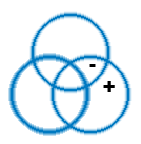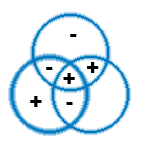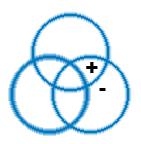Problem
Analyze the logical forms of the following statements. You may use the symbols  in your answers, but not
in your answers, but not  . (Thus, you must write out the definitions of some set theory notation, and you must use equivalences to get rid of any occurrences of
. (Thus, you must write out the definitions of some set theory notation, and you must use equivalences to get rid of any occurrences of  .)
.)




Solution
1.

 is a family of sets. Any member of
is a family of sets. Any member of  , a set, is a power set of A.
, a set, is a power set of A.
So  .
.
Every member of  is in $latex \mathcal P(A) $
is in $latex \mathcal P(A) $

To say that  means that
means that  .
.

We’ll introduce x to mean a member of y.

2.

Definition of subset:


3.

Definition of subset:


Need to use n and m to allow for different values, since these were two different statements.
4.

There is some set that is a power set of the union of the family of A that is not a subset of the union of all power sets of the family of A.

Add some context
![\exists y [ y \in \mathcal{P} (\bigcup \limits_{i \in I} A_i) \land y \notin \bigcup \limits_{i \in I} \mathcal P(A_i)]](https://s0.wp.com/latex.php?latex=%5Cexists+y+%5B+y+%5Cin+%5Cmathcal%7BP%7D+%28%5Cbigcup+%5Climits_%7Bi+%5Cin+I%7D+A_i%29+%5Cland+y+%5Cnotin+%5Cbigcup+%5Climits_%7Bi+%5Cin+I%7D+%5Cmathcal+P%28A_i%29%5D+&bg=ffffff&fg=2b2b2b&s=0&c=20201002)
Power Set:  .
.
![\exists y [ \forall x (x \in y \to x \in \bigcup \limits_{i \in I} A_i) \land y \notin \bigcup \limits_{i \in I} \mathcal{P}(A_i)]](https://s0.wp.com/latex.php?latex=%5Cexists+y+%5B+%5Cforall+x+%28x+%5Cin+y+%5Cto+x+%5Cin+%5Cbigcup+%5Climits_%7Bi+%5Cin+I%7D+A_i%29+%5Cland+y+%5Cnotin+%5Cbigcup+%5Climits_%7Bi+%5Cin+I%7D+%5Cmathcal%7BP%7D%28A_i%29%5D+&bg=ffffff&fg=2b2b2b&s=0&c=20201002)
Family Union: 
![\exists y [ \forall x (x \in y \to \exists i \in I (x \in A_i)) \land y \notin \bigcup \limits_{i \in I} \mathcal{P}(A_i)]](https://s0.wp.com/latex.php?latex=%5Cexists+y+%5B+%5Cforall+x+%28x+%5Cin+y+%5Cto+%5Cexists+i+%5Cin+I+%28x+%5Cin+A_i%29%29+%5Cland+y+%5Cnotin+%5Cbigcup+%5Climits_%7Bi+%5Cin+I%7D+%5Cmathcal%7BP%7D%28A_i%29%5D+&bg=ffffff&fg=2b2b2b&s=0&c=20201002)
Negation
![\exists y [ \forall x (x \in y \to \exists i \in I (x \in A_i)) \land \neg (y \in \bigcup \limits_{i \in I} \mathcal P(A_i))]](https://s0.wp.com/latex.php?latex=%5Cexists+y+%5B+%5Cforall+x+%28x+%5Cin+y+%5Cto+%5Cexists+i+%5Cin+I+%28x+%5Cin+A_i%29%29+%5Cland+%5Cneg+%28y+%5Cin+%5Cbigcup+%5Climits_%7Bi+%5Cin+I%7D+%5Cmathcal+P%28A_i%29%29%5D+&bg=ffffff&fg=2b2b2b&s=0&c=20201002)
Does this work? What does it mean to be a union of power sets? Same goes for the question itself.
Family Union:  . If y contains all the members x, then there is a set
. If y contains all the members x, then there is a set  that also contains all members x.
that also contains all members x.
![\exists y [ \forall x (x \in y \to \exists i \in I (x \in A_i)) \land \neg (\exists i \in I \forall x (x \in y \to x \in \mathcal P(A_i)))]](https://s0.wp.com/latex.php?latex=%5Cexists+y+%5B+%5Cforall+x+%28x+%5Cin+y+%5Cto+%5Cexists+i+%5Cin+I+%28x+%5Cin+A_i%29%29+%5Cland+%5Cneg+%28%5Cexists+i+%5Cin+I+%5Cforall+x+%28x+%5Cin+y+%5Cto+x+%5Cin+%5Cmathcal+P%28A_i%29%29%29%5D+&bg=ffffff&fg=2b2b2b&s=0&c=20201002)
Power Set: 
![\exists y [ \forall x (x \in y \to \exists i \in I (x \in A_i)) \land \neg (\exists i \in I \forall x (x \in y \to (x \in y \to x \in A_i)))]](https://s0.wp.com/latex.php?latex=%5Cexists+y+%5B+%5Cforall+x+%28x+%5Cin+y+%5Cto+%5Cexists+i+%5Cin+I+%28x+%5Cin+A_i%29%29+%5Cland+%5Cneg+%28%5Cexists+i+%5Cin+I+%5Cforall+x+%28x+%5Cin+y+%5Cto+%28x+%5Cin+y+%5Cto+x+%5Cin+A_i%29%29%29%5D+&bg=ffffff&fg=2b2b2b&s=0&c=20201002)
Conditional
![\exists y [ \forall x (x \in y \to \exists i \in I (x \in A_i)) \land \neg (\exists i \in I \forall x (x \notin y \lor x \notin y \lor x \in A_i)))]](https://s0.wp.com/latex.php?latex=%5Cexists+y+%5B+%5Cforall+x+%28x+%5Cin+y+%5Cto+%5Cexists+i+%5Cin+I+%28x+%5Cin+A_i%29%29+%5Cland+%5Cneg+%28%5Cexists+i+%5Cin+I+%5Cforall+x+%28x+%5Cnotin+y+%5Clor+x+%5Cnotin+y+%5Clor+x+%5Cin+A_i%29%29%29%5D+&bg=ffffff&fg=2b2b2b&s=0&c=20201002)
Tautology
![\exists y [ \forall x (x \in y \to \exists i \in I (x \in A_i)) \land \neg (\exists i \in I \forall x (x \notin y \lor x \in A_i)))]](https://s0.wp.com/latex.php?latex=%5Cexists+y+%5B+%5Cforall+x+%28x+%5Cin+y+%5Cto+%5Cexists+i+%5Cin+I+%28x+%5Cin+A_i%29%29+%5Cland+%5Cneg+%28%5Cexists+i+%5Cin+I+%5Cforall+x+%28x+%5Cnotin+y+%5Clor+x+%5Cin+A_i%29%29%29%5D+&bg=ffffff&fg=2b2b2b&s=0&c=20201002)
Quantifier Negation and DeMorgan
![\exists y [ \forall x (x \in y \to \exists i \in I (x \in A_i)) \land (\forall i \in I \exists x (x \in y \land x \notin A_i)))]](https://s0.wp.com/latex.php?latex=%5Cexists+y+%5B+%5Cforall+x+%28x+%5Cin+y+%5Cto+%5Cexists+i+%5Cin+I+%28x+%5Cin+A_i%29%29+%5Cland+%28%5Cforall+i+%5Cin+I+%5Cexists+x+%28x+%5Cin+y+%5Cland+x+%5Cnotin+A_i%29%29%29%5D+&bg=ffffff&fg=2b2b2b&s=0&c=20201002)
let
.
, for
.
and
.
, for
.
= {2, 3, 1, 4}.
= {3, 4, 2, 6}.
= {4, 5, 3, 8}.
= {5, 6, 4, 10}.
and
.
= {4}.
= {1, 2, 3, 4, 5, 6, 8, 10}.

















